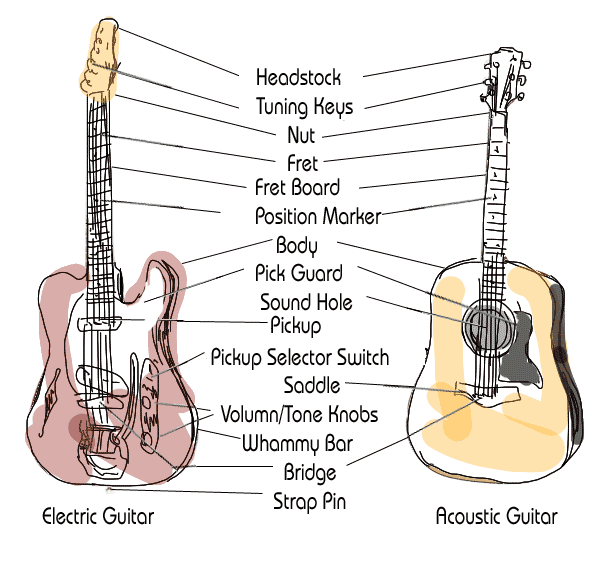Congratulations on your decision to learn to play the guitar! The guitar is a fun and rewarding instrument to play. Pick up and play your guitar as often as possible and you will succeed.
Unlike most other instruments, there are many different styles of guitars available, from acoustic to electric, but for our lesson we will concentrate on the standard six string guitar. Whether your guitar is acoustic or electric doesn't matter for these lessons, however, if your guitar is electric, make sure you have an amplifier to plug it into so you can hear what you are doing!
In this lesson we will familiarize ourselves with the parts of the guitar and learn how they function:

This illustration shows you the similarities and differences between acoustic and electric guitars. Your guitar should be similar to one of these instruments.
Strings
First we will discuss the obvious - the strings.
Most guitars have six strings. There are variations. In Choro music the guitar has a seventh string. Tenor and bass guitars only have four strings and 12-string guitars have six pairs of strings. It is assumed you have a six-string guitar, however, if your guitar happens to be a 12-string, it will work too, but it will be more work to tune.
The strings are numbered from thinnest (or furthest right as you face the guitar) to thickest (or furthers left) 1 - 2 - 3 - 4 - 5 - 6, 1 being the thinnest and 6 the thickest. This can sometimes be a little confusing because as you look at the guitar from the front, the strings are:
| | | | | |
| | | | | |
6 5 4 3 2 1
Good strings are important for sound and playability. It is recommended that you have a set of light gauge strings installed on your guitar for now. Light strings are easier to push down and won't wear out your fingertips as fast.
The headstock holds the tuning keys - these are used to tune the guitar, a process that must be repeated frequently. More about tuning later.
The nut is what the strings pass over when they leave the headstock. On some guitars there is a fret (see below) beside the nut - if you have one, this is referred to as the zero fret.
The long, slightly curved board, frequently made of rosewood, is the fretboard. As its name implies, it's covered with frets and fret markers. The frets are used to make the various notes by placing your fingers behind them and pressing down to the board. The fret markers are placed behind the 3rd, 5th, 7th, 9th, 12th, 15th and 17th frets (counted starting at the nut). The fret markers are usually duplicated on the side of the neck too. These markers are used as visual guides so you can tell at a glance which fret you are on (you don't want to have to count all the time to find your position). Though it isn't indicated on this chart, this entire portion of the guitar is referred to as the neck.
After the headstock and neck comes the body. Here you will see more differences between an acoustic and electric guitar.
On both guitars you will find pick guards and bridges. The pick guard protects the top of the guitar from damage when a pick (or plectrum) is used (more about the pick later). The strings pass over a bridge before they are secured to the guitar, either through the use of push-pins on an acoustic guitar, or a series of hitch pins and loop-ends on an electric. The bridge determines the length of each string (from the nut to the bridge) and if you look at it closely, you will see that it is not straight across, but angled. This is because some strings need to be a little longer than others to play in tune.
On an acoustic guitar the bridge, which is mounted on a saddle, is the point where the sound is transferred to the body of the guitar. The string vibrates the bridge, which vibrates the saddle, which makes the top of the guitar vibrate. The large space inside the guitar amplifies this vibration, and also adds color to the sound, and then the sound is projected out of the sound hole.
Electric guitars typically do not need this set-up to be heard, though there are acoustic-electric guitars. Instead of vibrating a saddle, the vibrations of the strings are detected by a series of pick-ups, which transfers the sounds through electronic circuits, giving you the ability to alter the volume and tone color of the sound before it is output to the amplifier. The guitar in this illustration is partially hollow and has a small hole in the top on the left side, called an f hole because of its shape. This guitar will be audible when it is played without an amplifier, but it will not be very loud. Electric guitars with a solid body are typically very quiet and unusable when played without an amplifier. One of the characteristics of solid body guitars is their sustain. Their hard wood body typically causes strings to vibrate longer.
Though only indicated on the electric guitar, both typically have pins on the bottom for a strap. This is to attach a guitar strap so the instrument will remain in playing position if played while standing. For now we will play from a seated position so don't worry about a strap.
Once you are familiar with the parts of the guitar you are ready for
lesson two.












